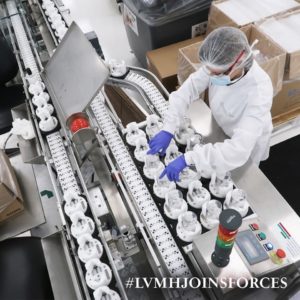Leading with agility to overcome supply chain and employee safety challenges

The world as we know it has changed due to the COVID-19 pandemic and consumer goods companies are in the middle of this storm. Specifically, demand for essential products from food to hand sanitizers has exploded while the supply chains to deliver them have been significantly disrupted. Just a few weeks ago, Forbes quoted P&G stating “We access 387 suppliers in China that ship to us globally more than 9,000 different materials, impacting approximately 17,600 different finished product items…(and) each of these suppliers faces their own challenges in resuming operations.” Across the Consumer Goods industry this is a common theme and accordingly one of the biggest challenges has been to continue to deliver safe, effective products for the consumer while keeping operations safe for employees.
As companies and employees have begun to adapt manufacturing and supply chain operations, with some employees working remotely for the first time in their careers, many are finding vital information to work with their suppliers and contract manufacturers is not readily available or accessible. For some this has created an environment that has been “reactive and uncoordinated, and the impact of the circus is hitting many of their companies full force,” according to the Harvard Business Review (HBR). However, the organizations that have already modernized operations and collaboration both internally and with supply chain partners have been able to move faster and with lower risk than the 65% that are still getting by with a patchwork of email, spreadsheets and legacy software. For example, HBR reported the results of a survey conducted by Resilinc in late January and early February, which found that “seventy percent of respondents said they were still in data collection and
assessment mode, manually trying to identify which of their suppliers had a site in the specific locked-down regions of China.”
Unfortunately, the unprecedented supply chain and manufacturing disruptions Consumer Goods companies are experiencing today have been an unwelcome wake-up call. There is an urgent need to invest in new approaches and modern solutions that increase agility, especially when working with suppliers and contract manufacturers, without compromising quality or compliance. As a recent McKinsey report put it, “Agility was desirable and is now becoming essential.”
Invest in agility? Right now? The knee jerk reaction might be to pause initiatives and focus on the core business of meeting consumer demand and staying afloat. Or that digitalization or a supply chain-wide agility transformation are major changes that will take a long time to put in place and would require resources that are needed elsewhere. Instead of thinking can I afford to spend time and resources on this, one should be thinking can I afford not to?
Agility in working with suppliers and contract manufacturers has never been more important. Just look at what the best consumer goods companies have been able to achieve in the past few weeks by adjusting manufacturing and working closely with suppliers. Would you have believed that LVMH could adapt its perfume factories to produce hand sanitizer in 72 hours? Or that Dyson could design and start production on a new ventilator in 10 days? Other examples of agility and collaboration are also highlighted in the positive actions and best practices being shared by The Consumer Goods Forum and its members. The CGF Board has also called for greater collaboration to help secure global product supply chains.
What are some of the biggest barriers to agility in adapting operations and supplier collaboration at your company today? Here are a few examples we’ve seen at consumer goods companies:
- Supplier audits are in-person and slow (or impossible in the current circumstances).
- Supplier information / documentation is scattered across email inboxes, spreadsheets, local folders, and other locations. It’s time-consuming to find the right document, and even if you do find it, you’re not confident it’s the most recent version.
- Keeping suppliers up to date on the latest SOPs, specifications and training is difficult, particularly when trying to quickly bring on new suppliers given supply chain disruptions.
The circumstances we find ourselves in demand us to be agile, without compromising on product or employee safety – not just in how and where we work, or collaborate with our suppliers, but even in how we approach solving business problems.
Where to start? I recommend breaking down the large problems like “supplier collaboration” into smaller initiatives that address specific, measurable issues can be implemented and tested quickly, and then rapidly scale the winners. This will lead to better decisions, faster results and bigger impacts for your business, both as you deal with the fallout from COVID-19 as well as making you stronger as we emerge from this pandemic.
This blog was written and contributed by:
Bruce Beilfuss
Vice President, Strategy, Consumer Goods
Veeva

